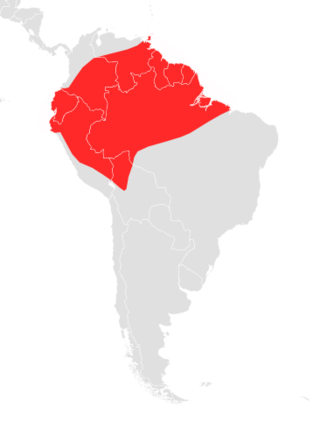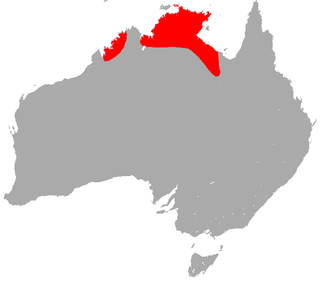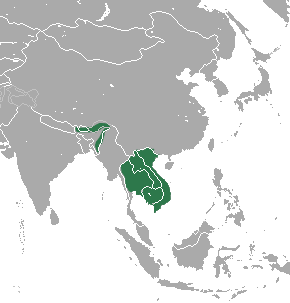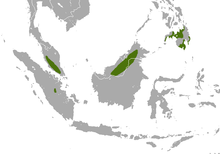
The long-tailed vole, in some areas known as the San Bernardino long-tailed vole, is a small vole found in western North America. They have short ears and a long tail. Their fur is gray brown with light gray underparts. They are around 18 cm (7.1 in) long with an 8 cm (3.1 in) tail and weigh about 50 g (1.8 oz).

The long-tongued nectar bat, also known as the northern blossom bat, honey nectar bat, least blossom-bat, dagger-toothed long-nosed fruit bat, and lesser long-tongued fruit bat, is a species of megabat. M. minimus is one of the smallest species in the family Pteropodidae, with an average length of 60–85 mm. It has a reddish-brown colouring with relatively long hair compared to the other species. The hair on the abdomen is a lighter colour, and a dark brown stripe runs bilaterally down the top of the head and back.
Megaerops is a genus of megabat.

The lesser long-tongued bat, also called the lesser long-tailed bat, is a bat species from South America.

The long-clawed shrew is a species of shrew. An adult long-clawed shrew has a weight of less than 20 grams (0.71 oz) and a body length of 54 millimetres (2.1 in) to 97 millimetres (3.8 in), with a tail of 40 millimetres (1.6 in) to 53 millimetres (2.1 in). It is distributed through the uplands of northeastern Asia, including northeastern North Korea.
Sokolov's dwarf hamster is a species of rodent in the hamster and vole family Cricetidae. Previously listed as conspecific with Chinese striped hamster, it has been listed as a separate species since 1988. It has a distinctive dark stripe down its back on and otherwise grey body. It is found in China and Mongolia, and lives in burrows beneath desert shrubs.
Nephelomys auriventer, also known as the golden-bellied oryzomys or Ecuadorian rice rat, is a species of rodent in the genus Nephelomys of family Cricetidae. Oldfield Thomas originally described it, in 1899, as a species of Oryzomys, Oryzomys auriventer, and considered it most similar to Oryzomys aureus. In 1926, a subspecies was described from an Ecuadorian locality, Oryzomys auriventer nimbosus, and it was suggested that O. auriventer was closely related to O. albigularis. This proposal was formalized in 1961 by including O. auriventer within the species O. albigularis, but by 1976 O. auriventer was recognized again as a separate species. In 2006, Oryzomys albigularis and related species, including O. auriventer, were transferred to the new genus Nephelomys. Simultaneously, the former subspecies nimbosus was recognized as a separate species, Nephelomys nimbosus.

Nephelomys devius, also known as the Talamancan oryzomys, Boquete rice rat, Chiriqui rice rat, or montane rice rat, is a species of rodent in the genus Nephelomys of family Cricetidae. It is found in cloud forest in the highlands of Costa Rica and western Panama.

The bushy-tailed jird or bushy-tailed dipodil is a species of rodent in the family Muridae. It is the only species in the genus Sekeetamys. It is found in Egypt, Israel, Jordan, Saudi Arabia, and Sudan. Its natural habitat is rocky areas.
Thorius pennatulus is a species of salamander in the family Plethodontidae and one of the smallest tetrapods, with adults reaching a length of about 15 to 21 millimetres . It is endemic to the mountains of Veracruz, Mexico.

The northern leaf-nosed bat is a micro-bat of the family Hipposideridae, known as "leaf-nosed" bats. The species is endemic to northern regions of Australia. They are highly manoeuvrable in flight, and use echolocation to forage for insect prey.

The Ratanaworabhan's fruit bat is a species of megabat in the family Pteropodidae. It is found in Bhutan, India, Thailand, and Vietnam.
Nephelomys meridensis, also known as the Mérida oryzomys, is a species of rodent in the genus Nephelomys of family Cricetidae. It is found in cloud forest in the Sierra Nevada de Mérida of western Venezuela at elevations from 1100 to 4000 m. It is solitary, nocturnal and terrestrial, and has a varied diet.

Hypsibarbus wetmorei, the golden belly barb, lemon fin barb,lemon barb or Kerai is a species of cyprinid fish. It is native to the Mae Klong, Mekong, Chao Phraya, Tapi and Pahang rivers in Mainland Southeast Asia. Although locally common and considered to be a species of Least Concern, it is threatened by overfishing, dams and pollution. It typically reaches 25 cm (10 in) in length, but has been recorded up to about 70 cm.

The Panay shrew is a species of shrew from the Philippines.
Acropora elegans is a species of acroporid coral that was first described by Henri Milne-Edwards in 1860. Found in sheltered, sloping reefs, this species occurs at 30 to 60 m depth. The species is listed as vulnerable on the IUCN Red List, and has a decreasing population. It is not common and has a small range, and is listed under CITES Appendix II. It is more resistant to disease than other Acropora species.
Acropora kosurini is a species of acroporid coral that was first described by C. C. Wallace in 1994. Found in marine, shallow reefs, it occurs at depths of 8 to 20 m. It is listed as a vulnerable species on the IUCN Red List, and it is believed to have a decreasing population. It is rare but found over a large area, and is listed on CITES Appendix II.
Acropora pharaonis is a species of acroporid coral that was first described by Milne-Edwards and Haime in 1860. Found in marine, tropical, reefs on slopes sheltered from wave action, it occurs at depths of between 5 and 25 m. It is classed as a vulnerable species on the IUCN Red List, and it has a decreasing population. It is common and found over a large area and is classified under CITES Appendix II.

Illiger's saddle-back tamarin is a species of saddle-back tamarin, a type of small monkey from South America. Illiger's saddle-back tamarin was formerly considered to be a subspecies of the brown-mantled tamarin, L. fuscicollis. It is closely related to the Andean saddle-back tamarin. It is endemic to the Peruvian Amazon and its type locality is in Loreto, Peru, at the left bank of the lower Rio Ucayali.

The Andean saddle-back tamarin is a species of saddle-back tamarin, a type of small monkey from South America. The Andean saddle-back tamarin was formerly considered to be a subspecies of the brown-mantled tamarin, L. fuscicollis. It is closely related to Illiger's saddle-back tamarin. It is endemic to Peru and its type locality is in the Department of Huanuco, Peru.













